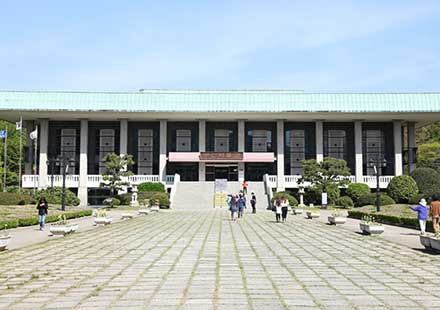HOME > Tourism > Busan Museum
Busan Museum

Busan Museum
- Location : 63, UN Pyeonghwa-ro, Nam-gu, Busan
- Contact : 051-610-7111
- Operating Hours : 09:00-20:00, Closed January 1 and every Monday, Admission hours : 09:00-19:00
- Website : http://museum.busan.go.kr/busan/Main.bs
Introduction
Opened in July 11, 1978, the Busan Museum was remodeled in May 2, 2002. The museum exhibits the wide array of relics found in Busan ranging from the prehistoric period to the present age, in order to support researches and to help the citizens of Busan to better understand Korean culture. Identifying the prehistoric, ancient and medieval cultures of the Busan region through academic research, conservation of excavated artifacts, archival and museum education, the museum strives to increase the understanding and awareness of our culture.

Exhibition
We conduct interactive exhibition activities to reveal a cultural background by the functional arrangement of various cultural data with cultural researchers’ study. The contents are divided into Permanent exhibition and Planning exhibition. The Permanent exhibition is one that displays exhibits all the time. The museum has six exhibition halls and an outdoor exhibition space, which are decorated with many kinds of artifacts and that show the course of Busan history from the Paleolithic period to the end of the Joseon Dynasty. On the other hand, Planning exhibition is a planned exhibition with special theme such as a specific age or field, locality, etc. About 60 planned exhibitions have been organized including Special exhibition of Shinhan Aquanaut Remains, Special exhibition of Unearthed Remains from Anapji, National Treasures of Peru, Exhibition of Gaya Cultures, Exhibition of Jin Emperor, Exhibition of Gold Treasure of Three Hans Period, Exhibition of the Ancient Egypt Civilization, Exhibition of Fishing Tackles and Exhibition of Educations, just to name a few.
Historic Site Survey
There are two fields of surveys. One is an archaeological field survey is to search for archaeological sites and collect information about the location. The other one is an excavation survey to showcase the archaeological remains in an excavation site. There are two types of excavation; research excavation is conducted when time and resources are available to excavate the site fully and at a leisurely pace, while development-led excavation is orchestrated when the site is threatened by building development.
Busan Museum’s main excavation sites are Deokcheon-dong Old tombs, Nopo-dong Old tombs, Dugu-dong Imseok(wooden stone) site, Bokcheondong Ancient Tombs, Gadal Old tombs, Mandeok-dong Field of Death, Danggam-dong ruins of a fortress, Haeundae Paleolithic site, Guemdan-point Boseongji, Cheonggangli Ancient Tombs, Dongsam-dong Shell Midden, Beombang Shell Mounds, etc.
Busan Museum’s main excavation sites are Deokcheon-dong Old tombs, Nopo-dong Old tombs, Dugu-dong Imseok(wooden stone) site, Bokcheondong Ancient Tombs, Gadal Old tombs, Mandeok-dong Field of Death, Danggam-dong ruins of a fortress, Haeundae Paleolithic site, Guemdan-point Boseongji, Cheonggangli Ancient Tombs, Dongsam-dong Shell Midden, Beombang Shell Mounds, etc.
Management of Artifacts
A series of responsibilities held by the museum are to collect the artifacts through purchasing, donations, consignment and warehousing, and preserve and manage the collected remains. In particular, in the case of fragile pottery and soft earthenware and highly corrosive metal artifacts made with iron and bronze, we apply a scientific conservation process through state-of-the-art conservation equipment operated by professional conservators. Through a course of registration process such as measuring, photographing and surveying, archived data of the collected artifacts are managed systematically. Moreover, all artifacts in the possession of the museum are documented and registered in the Cultural Heritage Administration. Yet, in principle, when the excavated cultural heritage is vested to the Korean government, they are consigned to the museum for public viewing and warehousing.
Academic Research
The museum researches and publishes a series of reports regarding excavated historic sites and publishing research collection of thesis papers. The reports on the excavated remains can be prepared through the process of drawing of the old structures confirmed through excavation and excavated remains, photographing, making drafts, printing, etc. The completed reports are distributed to experts, museums and libraries as their first reference materials. Reports that have been published so far are 『Deokcheon-dong Ancient Tombs』『Nopo-dong site』『1, 2 Dugu-dong site』『 Bokcheon-dong site』 『The 53rd tomb of Bokcheon-dong』『Saenggok-dong Gadal Ancient Tombs 1』『 Mandeok-dong field of death』『 Beombang Shell Midden 1, 2』『 Danggam-dong ruins of a castle 1』『 Guemdan point Boseongji』『Jinju Gwigok-dong Daechon site』, etc. In addition, culture researchers of Busan Museum started publishing research collections of thesis papers to include individual results from the research since 1992. Up to this time, a total of 8 collections have been distributed.
Education
Busan Museum is a type of a cultural center that promotes the cultural development of our community and its members. In order to orchestrate this role, we provide many kinds of social education programs. The social education programs include museum lectures for adult and children since 1985, Traveling Culture School since 1993, museum college, and invitational lectures of renowned scholars at home and abroad since 1992 to the present, etc. In addition, various social education programs such as tour guide training, history lectures, etc. are arranged. We wish for all of you to participate in various programs with enthusiasm and interest.

Directions
Transportation information
-
Busan Station (Nampo-dong direction) 134 :
Get off at Busan Museum stop and walk 5 minutes towards UN Rotary
Seo-myeon (Gaya direction) 68 :Get off at Busan Museum stop and walk 5 minutes towards UN Rotary
Dongnae direction 51 :Get off at Busan Museum stop and walk 5 minutes towards UN Rotary
Haeundae direction 139, 1001, 1003 :Get off at Busan Museum stop and walk 10 minutes towards UN Rotary
-
Subway Line 2 :
Get off at Daeyeon Station on Line 2 (Exit 3) and walk 10 minutes towards UN Rotary


